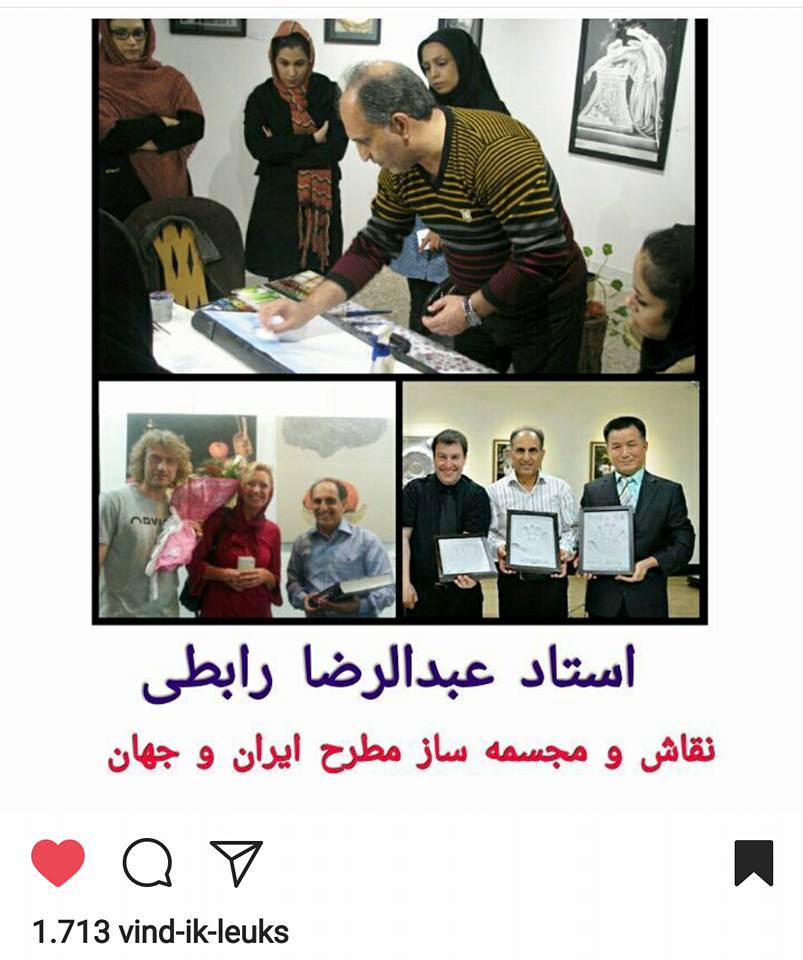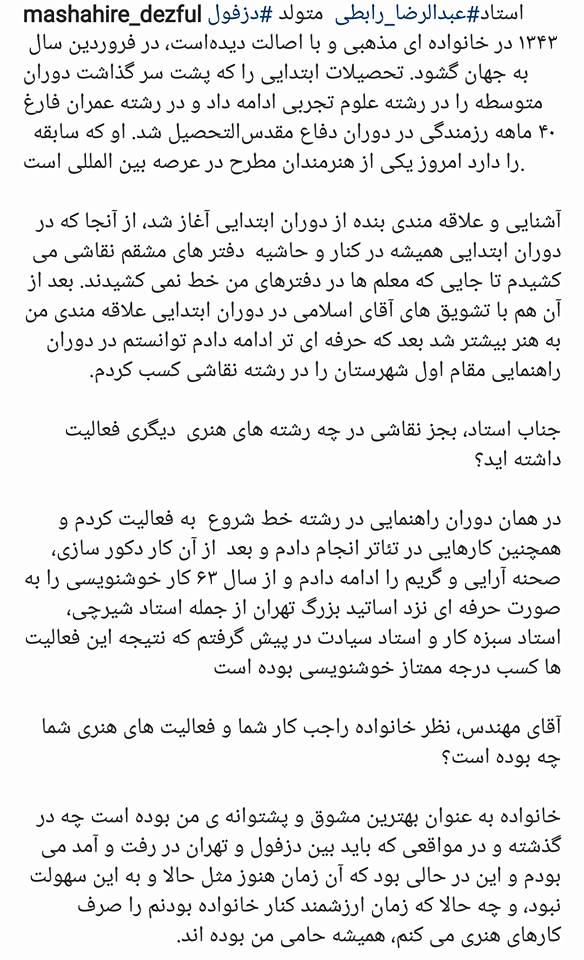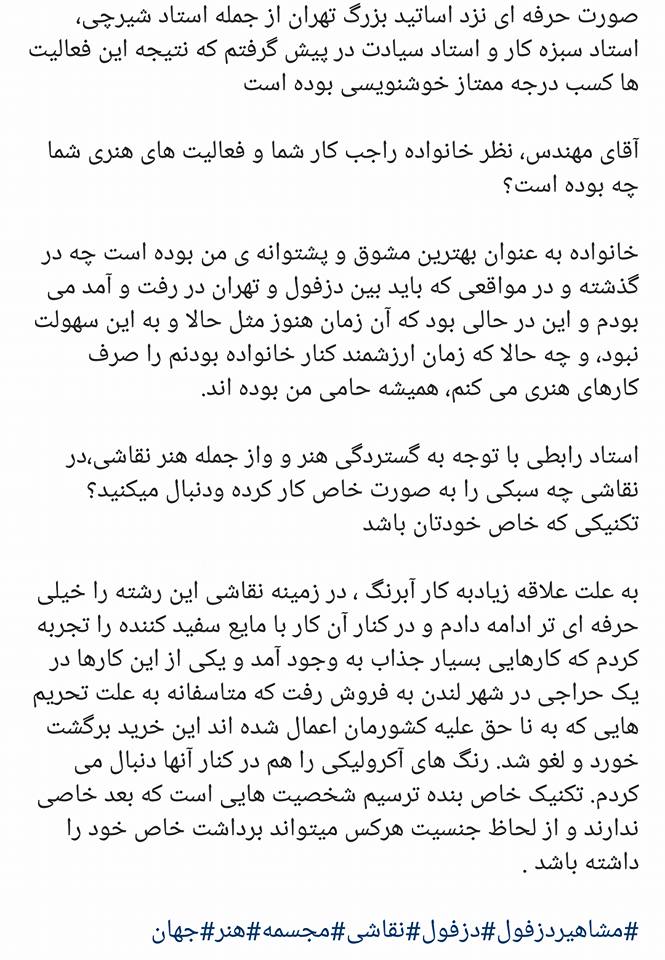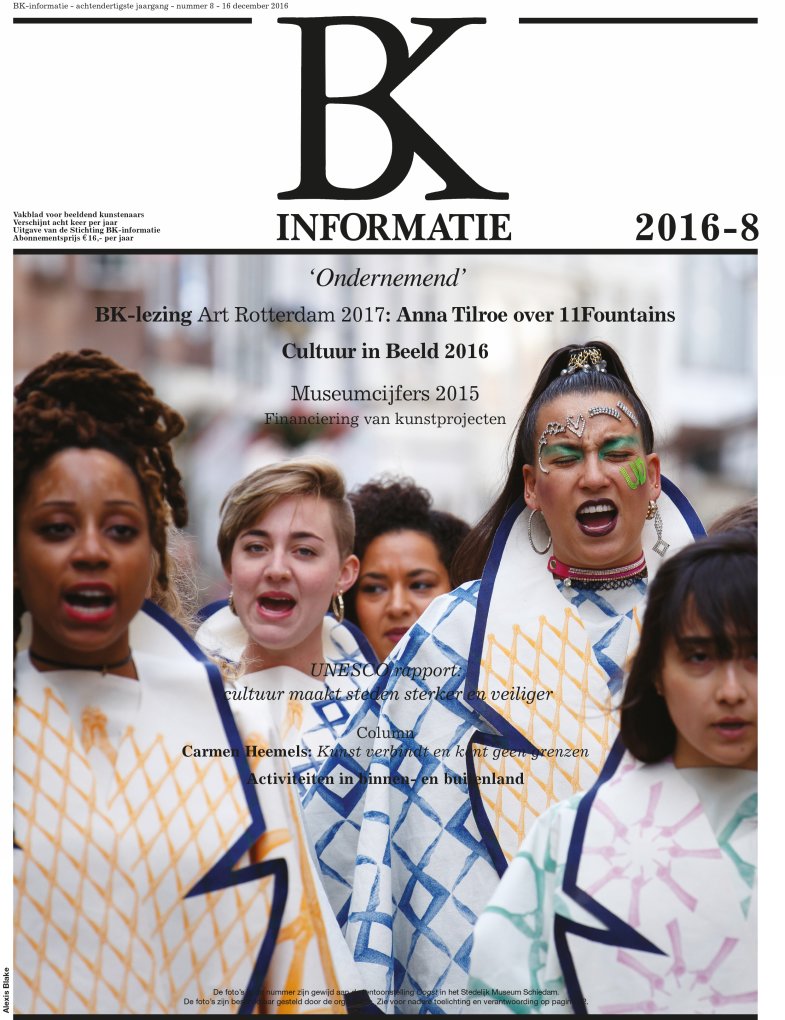
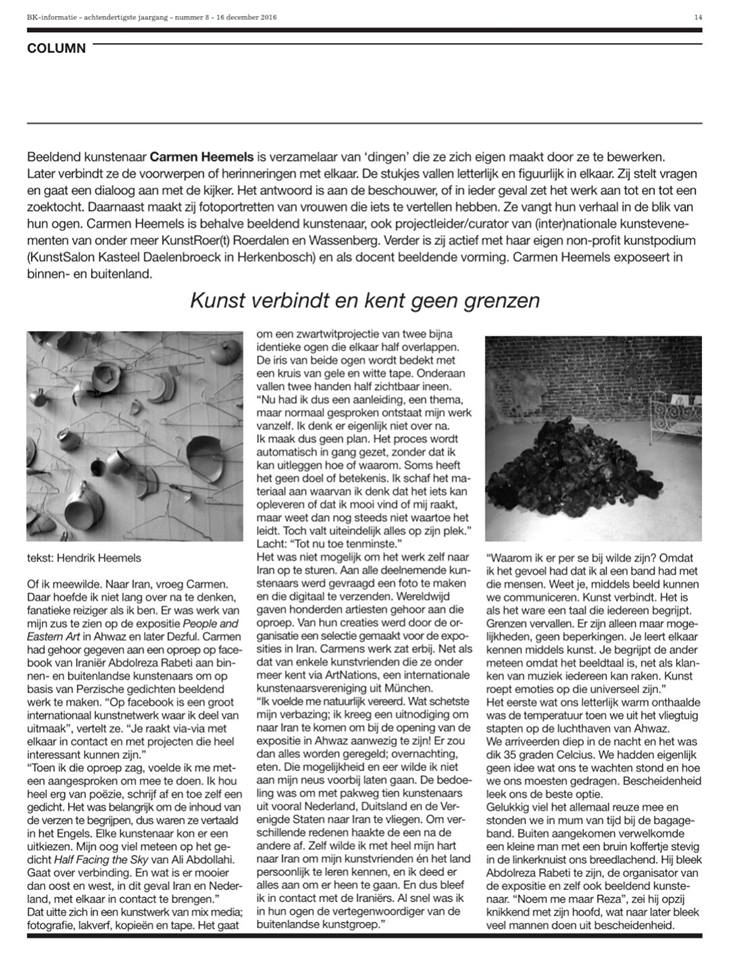
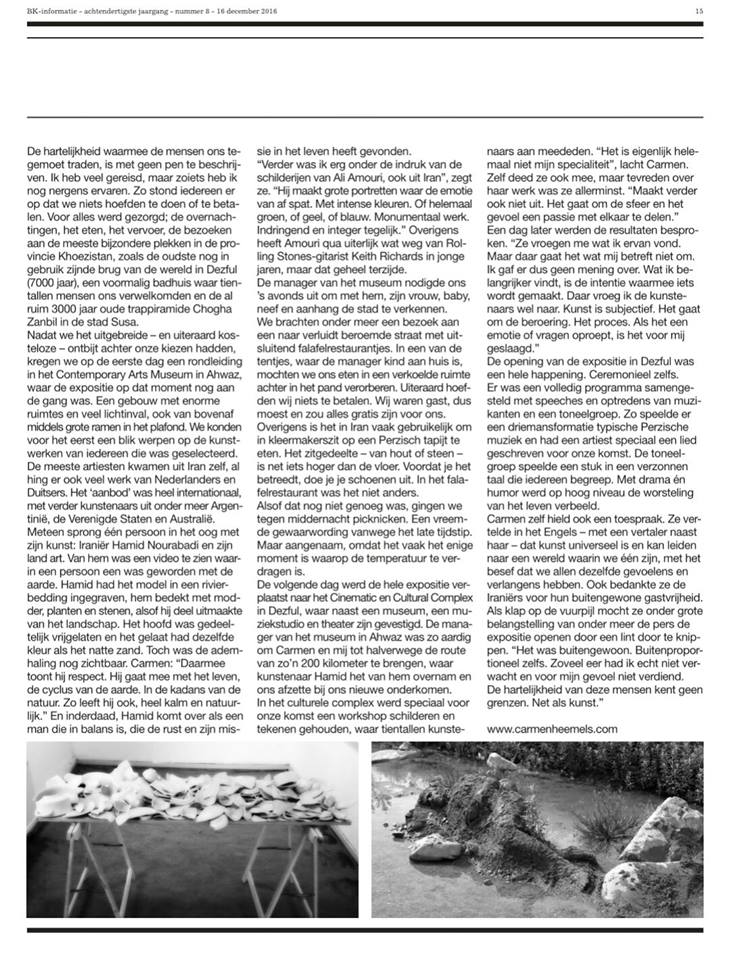
Article
BK information
Magazine The Netherlands
Visual Artist Carmen Heemels visits Iran
"Art connects and has no borders'
By Hendrik Heemels
If I wanted to go. To Iran, Carmen asked. I did not have to think long about it, avid traveler as I am. There was work to see from my sister in the exhibition 'People and Eastern Art "in Ahwaz and Dezful. Carmen had responded to a call on facebook of Iranian Abdolreza Rabeti, to national and international artists to create visual art based on Persian poetry.
"On facebook is a major international art network where I belong," she says. "You get over-over contact with each other and with projects that can be very interesting."
."When I saw that call, I was immediately approached me to get involved. I love poetry, write occasionally a poem myself. It was very important to understand the content of the verses, so they were translated into English. Each artist could take a pick. My eyes immediately fell on the poem "Facing Half the Sky" by Ali Abdollahi. It's about connection. ' And what could be better than East and West, in this case Iran and the Netherlands, into contact with each other. "
That was reflected in a mix of art media; photography, lacquer, copies and tape. It involves monochrome projection of two nearly identical eyes overlapping each other halfway. The iris of both eyes is covered with a cross of yellow and white tape. At the bottom are two hands half-visible.
"Now I had a reason, a theme, but my work is created normally by itself. I do not really think over. So I do not plan. The process goes automatically put into motion, though I can not explain how or why. Sometimes it has no purpose or meaning. I find or buy the material that I think anything can generate, or that I like, but still do not know where it leads. But ultimately everything falls into his place." Laughs: "So far, at least."
It was not possible to send the work itself to Iran. To all the participating artists were asked to take a photo and send digitally. Worldwide gave hundreds of artists responded to that call. Of their work was made a selection by the organization for the exhibitions in Iran. Carmen was selected. Like several of her friends that she knows, including some people from ArtNations, an international artists-organisation in Müchen, Germany'.
"I felt honored, of course. What my surprise; I received an invitation to come to Iran to attend the opening of the exhibition in Ahwaz! It would all be arranged for us; lodging, food. That possibility I really wanted to seize.
The intention was to fly with about ten artists from mainly the Netherlands, Germany and the United States to Iran. For various reasons, pulled out one after the other. Personally, I wanted with all my heart to go to Iran to my art friends and get to know the country in person, and did everything for going there. And so I stayed in contact with the Iranians. Soon I was in their eyes, the representative of the international art group. "
"Why I wanted to be in there necessarily? Because I felt that I had a relationship with those people. You know, we can communicate through images. Art connects. It's like a language everyone understands. Limits expire. You only see possibilities, not limitations. You get to know each other through art. You immediately understand each other because art is a visual language, like music can be. Art evokes emotions that are universal. "
The first thing we literally hot entertained the temperature when we got off the plane at the airport of Ahwaz. We arrived late at night and it was 35 degrees Celsius. We actually had no idea what was waiting for us and how we should behave. Modesty seemed the best option.Fortunately, it was not all that bad at all and we were in no time at the baggage claim. Outside arrived, a nice man with a brown briefcase firmly in his hand welcomed us smiling broadly. He appeared to be Abdolreza Rabeti, the organizer of the exhibition and he is also an artist himself. "Call me Reza," he said, nodding his head aside, as it turned out, many men do out of modesty.
The cordiality with which people acted towards us, is indescribable. I have traveled a lot, but something I have experienced anywhere. Everyone insisted that we did not have to do anything or pay. There was taken care of everything; The accommodation, food, transportation, visits to the most special places in the province of Khuzestan, as the oldest still in use bridge of the world in Dezful (7000 years), a former bathhouse where dozens of people welcomed us and all more than 3000 year old step pyramid Chogha Zanbil in the city of Susa.
Having extensive - and of course free of charge - breakfast, we got on the first day a tour of the Contemporary Arts Museum in Ahwaz, where the exhibition at the time was still ongoing. A beautiful building with huge rooms and lots of light, also from above through large windows in the ceiling. We could first take a look at the creations of everyone who was selected. Most artists came from Iran itself, but also a lot of work by Dutch and Germans. The "offer" was very international, with further artists from countries like Argentina, the United States and Australia.
Immediately jumped one artist in the eye with his work: Hamid Nour Abadi and his land-art. Of him showed a video in which a person had become one with the earth. Hamid buried his model in a river bed, he covered him with mud, plants and stones, as if he was part of the landscape. The head was partially released and the face was the same color as the wet sand. However, the breathing was still visible. Carmen: "Thus he shows respect. He goes with the life cycle of the earth. In the cadence of nature. He lives like that as well, very calm and natural. " Indeed, Hamid seems a man who is in balance, which has found the peace life and his mission.
"I was also very impressed by the paintings of Ali Amouri," she says. "He creates great portraits where the emotion palpable. With intense colors. All green, or yellow, or blue. Monumental work. Penetrating and honest at the same time. Moreover Amouri in appearance somewhay looks like Rolling Stones guitarist Keith Richards in the early years, but this completely aside.
The manager of the museum invited us in the evening to explore the town with him, his wife, baby, cousin and supporters. We spent a visit to an allegedly famous street with only falafel restaurants. In one of the restaurants, where the manager child is at home, we were allowed to eat in a room by devouring. And again we did not have to pay anything. We were guests, and so everything so kindly would be free for us. Moreover, it is often common in Iran to eat cross-legged on a Persian rug. The seating area - made of wood or stone - is slightly higher than the floor. Before you enter it, you take off your shoes. The falafel restaurant was no differently.
And so very kind: we went for a picnic at midnight. A strange sensation because of the late hour. But nice, because it is often the only time when the temperature is more bearable.
The next day the whole exhibition was transported to the Cinematic and Cultural Complex in Dezful, where in addition to a museum, a music studio and theater are located. A huge and great job of Reza! The manager of the museum in Ahwaz was so nice to drive Carmen and me halfway the route of about 200 kilometers, where Hamid took over from him and deposited us at our new home.
In the cultural complex was special for our coming a painting workshop and held signs, where dozens of artists participated. "It's actually not my speciality", Carmen tells. She herselve did it, but she wasn't satisfied with her work. "But this doesn't really matter. It's all about the atmosphere and the feeling of sharing a passion with each other. "
The day after, the results were discussed. "The artists asked me what I thought.But that's not what I am concerned about. I therefore I did gave no opinion. What I find more important is the intention how people create something. Art is subjective. It's about the turmoil. The process. As it evokes an emotion or questions, it passed me and worthful for me".
The opening of the exhibition in Dezful was quite an event. Even ceremonial. There was a whole program compiled with speeches and performances by musicians and a theater-show. For example, played three men typical Persian music and had an artist specially written a song for our arrival. The theater played a piece in an invented language that everyone understood. With drama and humor at a high level was depicted the struggle of life.
Carmen herself also gave a speech. She told in English - with an interpreter next to her - that art is universal and can lead to a world in which we are one, with the realization that we all have the same feelings and desires!
She also thanked the Iranians for their extraordinary hospitality.
As icing on the cake, with many people, artists and also the press with great interest include, she was invited to open the exhibition with a ribbon cutting. "It was extraordinary. Even out of Proportion. So Great! I really did not expect such a great honor, and certainly I did not have the feeling to deserve this. The cordiality and hospitality of these beautiful and kind people knows no bounds. Like art. "
THE DUTCH VERSION
Carmen Heemels opent expositie in Iran
‘Kunst verbindt en kent geen grenzen’
Door Hendrik Heemels
Of ik meewilde. Naar Iran, vroeg Carmen. Daar hoefde ik niet lang over na te denken, fanatieke reiziger als ik ben. Er was werk van mijn zus te zien op de expositie ‘People and Eastern Art’ in Ahwaz en later Dezful. Carmen had gehoor gegeven aan een oproep op facebook van Iraniër Abdolreza Rabeti aan binnen- en buitenlandse kunstenaars om op basis van Perzische gedichten beeldend werk te maken. ‘Op facebook is een groot internationaal kunstnetwerk waar ik deel van uitmaak’, vertelt ze. ‘Je raakt via-via met elkaar in contact en met projecten die heel interessant kunnen zijn.’
‘Toen ik die oproep zag, voelde ik me meteen aangesproken om mee te doen. Ik hou heel erg van poëzie, schrijf af en toe zelf een gedicht. Het was wel zo belangrijk om de inhoud van de verzen te begrijpen, dus waren ze vertaald in het Engels. Elke kunstenaar kon er een uitkiezen. Mijn oog viel meteen op het gedicht ‘Half Facing the Sky’ van Ali Abdollahi. Gaat over verbinding. En wat is er mooier dan oost en west, in dit geval Iran en Nederland, met elkaar in contact te brengen.’
Dat uitte zich in een kunstwerk van mix media; fotografie, lakverf, kopieën en tape. Het gaat om zwartwitprojectie van twee bijna identieke ogen die elkaar half overlappen. De iris van beide ogen wordt bedekt met een kruis van gele en witte tape. Onderaan vallen twee handen half zichtbaar ineen.
‘Nu had ik dus een aanleiding, een thema, maar normaal gesproken ontstaat mijn werk vanzelf. Ik denk er eigenlijk niet over na. Ik maak dus geen plan. Het proces wordt automatisch in gang gezet, zonder dat ik kan uitleggen hoe of waarom. Soms heeft het geen doel of betekenis. Ik schaf het materiaal aan waarvan ik denk dat het iets kan opleveren of dat ik mooi vind, maar weet dan nog steeds niet waartoe het leidt. Maar uiteindelijk valt alles op zijn plek.’ Lacht: ‘Tot nu toe tenminste.’
Het was niet mogelijk om het werk zelf naar Iran op te sturen. Aan alle deelnemende kunstenaars werd gevraagd een foto te maken en die digitaal te verzenden. Wereldwijd gaven honderden artiesten gehoor aan die oproep. Van hun werk werd door de organisatie een selectie gemaakt voor de exposities in Iran. Carmen zat daarbij. Net als enkele vrienden van haar die ze onder meer kent via ArtNations, een internationale kunstenaarsvereniging.
‘Ik voelde me natuurlijk vereerd. Wat schetste mijn verbazing; ik kreeg een uitnodiging om naar Iran te komen om bij de opening van de expositie in Ahwaz aanwezig te zijn! Er zou dan alles voor ons worden geregeld; overnachting, eten. Die mogelijkheid en eer wilde ik met beide handen aangrijpen. De bedoeling was om met pakweg tien kunstenaars uit vooral Nederland, Duitsland en de Verenigde Staten naar Iran te vliegen. Om verschillende redenen haakte de een na de andere af. Zelf wilde ik met heel mijn hart naar Iran om mijn kunstvrienden én het land persoonlijk te leren kennen, en deed er alles aan om er heen te gaan. En dus bleef ik in contact met de Iraniërs. Al snel was ik hun ogen de vertegenwoordiger van de buitenlandse kunstgroep.’
‘Waarom ik er per se bij wilde zijn? Omdat ik het gevoel had dat ik al een band had met die mensen. Weet je, middels beeld kunnen we communiceren. Kunst verbindt. Het is als het ware een taal de iedereen begrijpt. Grenzen vervallen. Je ziet alleen maar mogelijkheden, geen beperkingen. Je leert elkaar kennen middels kunst. Je begrijpt elkaar meteen omdat het beeldtaal is, net als muziek. Kunst roept emoties op die universeel zijn.’
Het eerste wat ons letterlijk warm onthaalde was de temperatuur toen we uit het vliegtuig stapten op de luchthaven van Ahwaz. We arriveerden diep in de nacht en het was dik 35 graden Celcius. We hadden eigenlijk geen idee wat ons te wachten stond en hoe we ons moesten gedragen. Bescheidenheid leek ons de beste optie.
Gelukkig viel het allemaal reuze mee en stonden we in mum van tijd bij de bagageband. Buiten aangekomen verwelkomde een aardige man met een bruin koffertje stevig in de linkerhand ons breed lachend. Hij bleek Abdolreza Rabeti te zijn, de organisator van de expositie en zelf ook beeldend kunstenaar. ‘Noem me maar Reza’, zei hij opzij knikkend met zijn hoofd, wat naar later bleek veel mannen doen uit bescheidenheid.
De hartelijkheid waarmee de mensen ons tegemoet traden, is met geen pen te beschrijven. Ik heb veel gereisd, maar zoiets heb ik nog nergens ervaren. Zo stond iedereen er op dat we niets hoefden te doen of te betalen. Voor alles werd gezorgd; de overnachtingen, het eten, het vervoer, de bezoeken aan de meeste bijzondere plekken in de provincie Khoezistan, zoals de oudste nog in gebruik zijnde brug van de wereld in Dezful (7000 jaar), een voormalig badhuis waar tientallen mensen ons verwelkomden en de al ruim 3000 jaar oude trappiramide Chogha Zanbil in de stad Susa.
Nadat we het uitgebreide - en uiteraard kosteloze - ontbijt achter onze kiezen hadden, kregen we op de eerste dag een rondleiding in het Contemporary Arts Museum in Ahwaz, waar de expositie op dat moment nog aan de gang was. Een gebouw met enorme ruimtes en veel lichtinval, ook van bovenaf middels grote ramen in het plafond. We konden voor het eerst een blik werpen op de creaties van iedereen die was geselecteerd. De meeste kunstenaars kwamen uit Iran zelf, al hing er ook veel werk van Nederlanders en Duitsers. Het ‘aanbod’ was heel internationaal, met verder artiesten uit onder meer Argentinië, de Verenigde Staten en Australië.
Meteen sprong één kunstenaar in het oog met zijn werk: Hamid Nourabadi en zijn landart. Van hem was een video te zien waarin een persoon een was geworden met de aarde. Hamid had het model in een rivierbedding ingegraven, hem bedekt met modder, planten en stenen, alsof hij deel uitmaakte van het landschap. Het hoofd was gedeeltelijk vrijgelaten en het gelaat had dezelfde kleur als het natte zand. Toch was de ademhaling nog zichtbaar. Carmen: ‘Daarmee toont hij respect. Hij gaat mee met het leven, de cyclus van de aarde. In de kadans van de natuur. Zo leeft hij ook, heel kalm en natuurlijk.’ En inderdaad, Hamid komt over als een man die in balans is, die de rust en zijn missie in het leven heeft gevonden.
‘Verder was ik erg onder de indruk van de schilderijen van Ali Amouri’, zegt ze. ‘Hij maakt grote portretten waar de emotie van af spat. Met intense kleuren. Of helemaal groen, of geel, of blauw. Monumentaal werk. Indringend en integer tegelijk.’ Overigens heeft Amouri qua uiterlijk wat weg van Rolling Stones-gitarist Keith Richards in jonge jaren, maar dat geheel terzijde.
De manager van het museum nodigde ons ’s avonds uit om met hem, zijn vrouw, baby, neef en aanhang de stad te verkennen. We brachten onder meer een bezoek aan een naar verluidt beroemde straat met uitsluitend falafelrestaurantjes. In een van de tentjes, waar de manager kind aan huis is, mochten we ons eten in een verkoelde ruimte achterdoor verorberen. Uiteraard hoefden wij niets te betalen. Wij waren gast, dus moest en zou alles gratis zijn voor ons. Overigens is het in Iran vaak gebruikelijk om in kleermakerszit op een Perzisch tapijt te eten. Het zitgedeelte – van hout of steen - is net iets hoger dan de vloer. Voordat je het betreedt, doe je je schoenen uit. In het falafelrestaurant was het niet anders.
Alsof dat nog niet genoeg was, gingen we tegen middernacht picknicken. Een vreemde gewaarwording vanwege het late tijdstip. Maar aangenaam, omdat het vaak het enige moment is waarop de temperatuur enigszins te verdragen is.
De volgende dag werd de hele expositie vervoerd naar het Cinematic en Cultural Complex in Dezful, waar naast een museum, een muziekstudio en theater zijn gevestigd. De manager van het museum in Ahwaz was zo aardig om Carmen en mij tot halverwege de route van zo’n 200 kilometer te brengen, waar Hamid het van hem overnam en ons afzette bij ons nieuwe onderkomen.
In het culturele complex werd speciaal voor onze komst een workshop schilderen en tekenen gehouden, waar tientallen kunstenaars aan meededen. ‘Het is eigenlijk helemaal niet mijn specialiteit’, lacht Carmen. Zelf deed ze ook mee, maar tevreden over haar werk was ze allerminst. ‘Maakt verder ook niet uit. Het gaat om de sfeer en het gevoel een passie met elkaar te delen.’
Een dag later werden de resultaten besproken. ‘Ze vroegen me wat ik ervan vond. Maar daar gaat het wat mij betreft niet om. Ik gaf er dus geen mening over. Wat ik belangrijker vindt, is de intentie waarmee iets wordt gemaakt. Kunst is subjectief. Het gaat om de beroering. Het proces. Als het een emotie of vragen oproept, is het voor mij geslaagd.’
De opening van de expositie in Dezful was een hele happening. Ceremonieel zelfs. Er was een heel programma samengesteld met speeches en optredens van muzikanten en een toneelgroep. Zo speelde er een driemansformatie typische Perzische muziek en had een artiest speciaal een lied geschreven voor onze komst. De toneelgroep speelde een stuk in een verzonnen taal die iedereen begreep. Met drama én humor werd op hoog niveau de worsteling van het leven verbeeld.
Carmen zelf hield ook een toespraak. Ze vertelde in het Engels - met een vertaler naast haar – dat kunst universeel is en kan leiden naar een wereld waarin we één zijn, met het besef dat we allen dezelfde gevoelens en verlangens hebben. Ook bedankte ze de Iraniërs voor hun buitengewone gastvrijheid.
Als klap op de vuurpijl mocht ze onder grote belangstelling van onder meer de lokale pers de expositie openen door een lint door te knippen. ‘Het was buitengewoon. Buitenproportioneel zelfs. Zoveel eer had ik echt niet verwacht en zeker voor mijn gevoel niet verdiend. De hartelijkheid van deze mensen kent geen grenzen. Net als kunst.’
